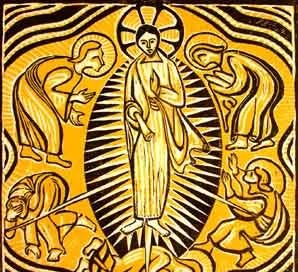The Last Sunday after the Epiphany
To read the lectionary texts for this Sunday, please click here.
As you’ll notice on the cover of your bulletins this morning,
today is the Last Sunday after the Epiphany in our liturgical calendar.
If you were to look at the bulletins of other churches
—say, St. Dominic’s across town—
you wouldn’t see ‘The Last Sunday after the Epiphany.’
You would see: ‘The Sixth Sunday in Ordinary Time.’
That’s what this season after Christmas and before Lent is called:
Ordinary Time.
Not an exciting time.
Not a festival time.
Not a solemn time.
Just…ordinary time.
And, at first pass, I think I get it.
We’ve concluded the Twelve Days of Christmas.
We’ve put away the tinsel and dragged the Christmas tree to the curb.
But we’ve not yet begun the Lenten journey toward Holy Week and Easter.
We’re not wearing the festival tapestry vestments of Christmas,
but neither are we wearing the penitential violet of Lent.
On the surface, these several weeks after the Epiphany
seem rather blah and, well, ordinary
compared to the seasons which bookend them.
And yet there is absolutely nothing ordinary about this season after Epiphany.
If you’ve been paying attention to the readings
over the past six or so weeks since Christmas,
you may have noticed a trend:
Beginning with Jesus’s baptism the Sunday after the Epiphany,
we’ve witnessed Jesus doing remarkable things wherever he goes.
His ministry begins with a dove descending at his Baptism
and the voice of God from heaven proclaiming Jesus as the very Son of God,
the One in Whom God is exceptionally well pleased.
And in the intervening weeks we’ve heard him preaching about the kingdom of God,
about heaven tearing open and angels descending.
We witnessed him call the disciples from their lives and livelihoods
and, based on his force of will or his charisma or the Holy Spirit warming their hearts,
we witness them following him.
We’ve seen him travel throughout the whole region, preaching and teaching.
We’ve seen him cast out demons a couple of times.
We’ve seen him heal.
And today is the pinnacle of the Season after the Epiphany
when Jesus takes Peter and James and John
(my friend Fr. Clarke calls these three the ‘Executive Team’ of the Disciples)
and they go for a hike up a mountain.
And while they’re on this hike, something awesome
—and I do mean that in the fullest sense of the word, literally full of awe—happens.
All of a sudden, everything around them changes.
Jesus’s clothes become dazzling white
and Elijah, the greatest of the Prophets
and Moses, the Great Law Giver
appear before them.
And, as it happened at his baptism,
the literal voice of God comes down from the sky
“This is my Son, the Beloved; listen to him!”
The Transfiguration is the perfect capstone for this Season after Epiphany
—this Extraordinary Ordinary Time—
and, as the Collect we prayed at the beginning of Mass affirms,
it is the perfect trailhead for our Lenten journey.
The Transfiguration is all about the grace and the glory of God
being made manifest here in this world.
God has been in the grace and glory business since before Time,
but it was not until the person of Jesus Christ
—the Word which took on flesh as we know from our Christmas celebration,
the Son of God in whom God is well pleased—
it is not until Jesus Christ that God’s grace and glory looked like us.
It was not until Jesus Christ that God’s grace and glory
was like us in every possible way.
The entirety of God’s grace and glory
—God’s own very presence—
right here as a human.
A human who could and did doubt.
A human who could and did get tired.
A human who could and did get angry.
A human who could and did dance.
A human who could and did love.
And the most marvelous thing is that this new revelation of God’s grace and glory
did not appear and say to everybody:
“Forget everything that’s come before me!”
No! The Law and the Prophets are literally represented here in this Transfiguration,
in this revelation of God’s grace and glory.
It would be tempting for us
—as it is for every generation—
to throw out what has come before us and to chart our own course.
But the Transfiguration
—with the imposing figures of Elijah and Moses—
tells us that that is not the wise course of action.
God’s grace and glory is limitless and ever-new,
but it is also a fulfillment of the Law and the Prophets.
God’s grace and glory is always concerned with the fullness of the Law,
that is the great command to love God with our whole hearts, minds, and bodies
and to love our neighbor as ourselves.
And like the Prophets
—like Elijah and Isaiah and Amos and Micah—
God’s grace and glory will always call us back into relationship with God,
with one another,
and with ourselves.
And did you catch Peter’s response to the transfiguration,
to the fullness of God’s grace and glory showing up right in front of him?
‘Rabbi, it is good for us to be here; let us make three dwellings,
one for you, one for Moses, and one for Elijah.’
He did not know what to say, for they were terrified.
As we heard some weeks ago, Jesus built his Church upon Peter
and so it’s no surprise that Peter the Rock,
Peter the first Bishop,
Peter the first Committee Chairman
responds to the fullness of God’s grace and glory
—responds to the terror of coming face to face with God’s presence—
by suggesting a capital campaign to begin a building project.
There’s something so human in Peter’s fearful suggestion to build dwelling places
for the holy people who have just appeared in front of his face.
When we encounter something that is magnificently wonderful
of course we want to contain it.
Of course we want to make sure that we’ll always have access to it
and that nothing can damage or deplete it.
Of course we want to pass it onto our children and to their children
so that they’ll appreciate the thing that so obviously moved us.
If the fullness of God’s grace and glory appears in front of your face,
then of course the reasonable course of action is to build a house for it.
But that’s not how God’s grace and God’s glory works, is it?
God’s grace and glory is not contained by buildings.
In fact, God’s grace and God’s glory cannot be contained at all!
We see in the Gospel this morning
—and in the past six weeks—
that the fullness of God’s grace and God’s glory
—the culmination of the Law and the Prophets—
is Jesus Christ himself,
the real MVP of all time and history
(move over, Travis Kelce!)

And, at the end of the story,
—after the heavens are silenced
and Moses and Elijah return to the Bosom of Abraham
or wherever it is they’re waiting for the Resurrection of the Dead—
after it all dissipates,
the fullness of God’s grace and glory
comes down from the mountain
and returns to everyday life.
God’s grace and glory does not need a building.
God’s grace and glory walks among us as us.
My friends, Jesus invites us to join with him by opening ourselves
to the fullness of God's grace and glory in our everyday lives.
Not on a mountain top somewhere.
But right here, right now.
This will look a hundred different ways for a hundred different people.
But at the end of the day, Jesus invites you and me and all of us to be transformed.
Jesus invites us to nestle in between the Law of Love and the Prophetic Call to Justice.
Jesus invites us to submit to God’s will in our lives
and to embrace our own identity as God’s beloved children,
as ones in whom God is exceptionally well pleased.
God is engaged in mission all around us
—in our homes and in our neighborhoods, in our offices and even on Facebook—
and Jesus is eager for us to join in God’s mission to the world,
giving ourselves to being good neighbors,
giving ourselves to the healing and redemptive work of forgiveness and reconciliation,
giving ourselves to prayer and contemplation,
giving ourselves to rest and renewal,
giving ourselves
—entirely and dazzlingly—
to God and to letting God move in and through and because of us.
By God’s own grace, may it be so. Amen.
This sermon was preached by the Rev. Cody Maynus at All Saints Episcopal Church, Northfield, MN.





